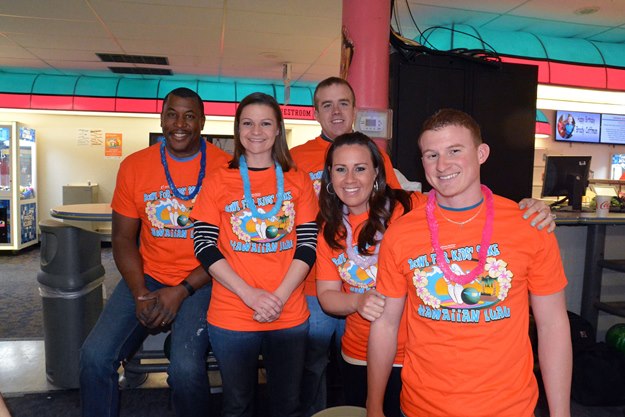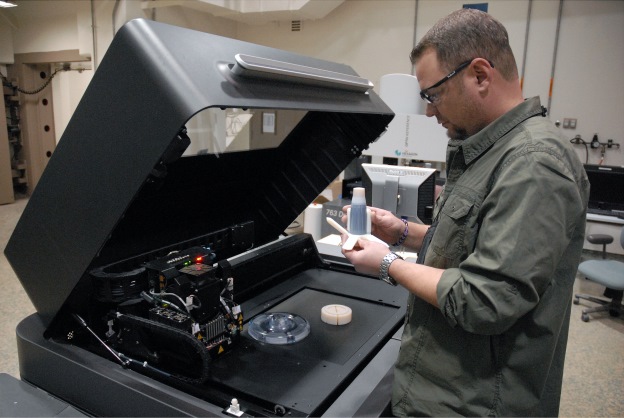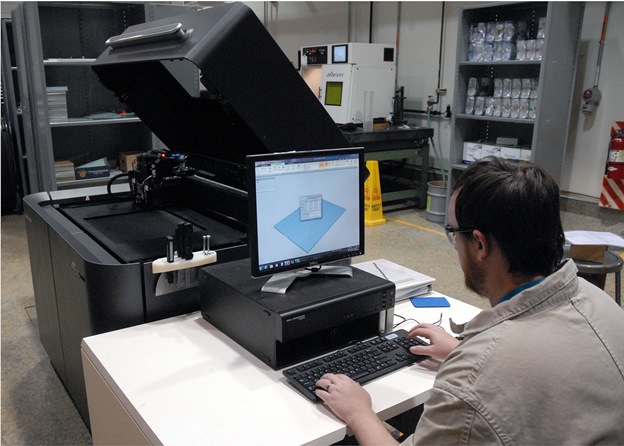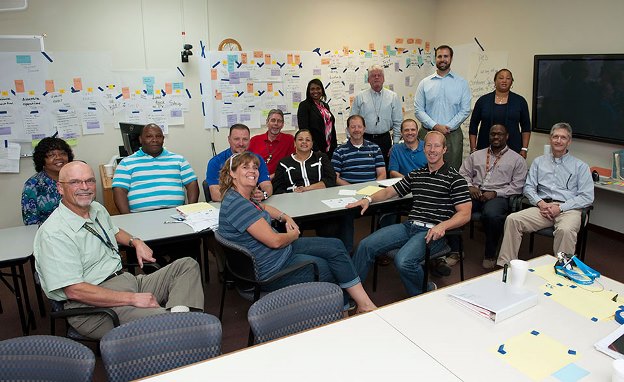Pantex Blog
Pantexans bowl for Big Brothers Big Sisters
Shouts of joy and laughter followed loud crashes of bowling pins hitting the floor as 35 teams of Pantexans packed Amarillo’s Western Bowl to lace up (or Velcro) their bowling shoes for the Big Brothers Big Sisters (BBBS) Bowl For Kids’ Sake “Hawaiian Luau” sponsored by Consolidated Nuclear Security, LLC (CNS).
 More than 143 employees and their families took to their lanes, vying for that perfect score of 300, proving yet again how Pantexans care about the BBBS mission for our community. For the last 10 years, more than 182 Pantex bowling teams have helped provide the needed funding to serve hundreds of children in the Texas Panhandle.
More than 143 employees and their families took to their lanes, vying for that perfect score of 300, proving yet again how Pantexans care about the BBBS mission for our community. For the last 10 years, more than 182 Pantex bowling teams have helped provide the needed funding to serve hundreds of children in the Texas Panhandle.
“We couldn’t do it without our continued support from CNS Pantex,” explained Emily Shelton Nance, executive director of BBBS of the Texas Panhandle, Inc.
Bowl For Kids’ Sake is one of the agency’s largest annual fundraisers, which accounts for more than 40 percent of its annual budget. CNS is proud to support BBBS and its mission to provide all children facing adversity with strong and enduring, professionally supported one-to-one relationships that change their lives for the better, forever.
“This was a great time for a great cause. I am privileged to have been a part of it,” said Mona Knox, Pantex Facilities Services.
Through fundraising efforts such as Bowl For Kids’ Sake, BBBS is able to fulfill an important role in the community. At absolutely no cost to the parent, the children (or “Littles”) are signed up and then matched up with a “Big” who agrees to spend a few hours a week with their match. The BBBS mission is to help children reach their full potential through professionally supported, one-to-one mentoring relationships.

The Alley Oops weren’t hard to spot in this year’s event t-shirts.
CNS securing success across both sites
Safeguards, Security and Emergency Services integrated, consolidated and standardized processes at Pantex and Y-12 in 2015. According to Gary Wisdom, SS&ES senior director at Pantex, “The exchange of information has been our greatest effort and our most valuable success. Integrating our knowledge, purpose and strategic initiatives can ultimately provide the greatest returns.”

Pantex Emergency Services members (from left) Maribel Martinez, Brenda Graham and Greg Roddahl learn how to use the Emergency Management Information System, or EMInS.
In many cases, the formalization and documentation of long‑established informal processes were major accomplishments. For example, in June 2015, the National Nuclear Security Administration Production Office approved consolidated rules of engagement and hostile intent policies for unmanned aerial systems at both CNS sites.
In July, essential elements terminology was standardized, and the organization decided to proceed with incorporating all governing documents into a single Requirement Management System, which assists with consolidating the flow down of Department of Energy requirements into site‑specific documents.
The enterprise infrastructure to facilitate and support these efforts is integral to their success. Training, Supply Chain Management, Document Control and other organizations must be integrated so that they can support integration at lower levels. Representatives from SS&ES, Transformation and Supply Chain Management developed a logistics plan to make it easier for SS&ES employees to get what they need to do their work on time and cost effectively.
“If we can reduce the time spent completing repetitive purchase paperwork, reduce the time it takes to get the items and services we need, that’s a big plus for everyone,” explained Brian Deorocki of SS&ES Integration Management. Items needed at both sites may be purchased in bulk, improving employee effectiveness and reducing costs.
The logistics plan simplifies these repetitive and multi‑year procurements of specialized supplies, parts and equipment, as well as maintenance, service and repair contracts. Protective Force personnel at both sites worked together to develop a statement of work for a firearms maintenance capability at Anniston Army Depot. The depot possesses machines, parts and tools to renovate and refurbish military firearm systems and restore them to current military specifications, a capability not available at Pantex or Y-12. Both sites have provided additional statements of work for other site‑specific weapons and have coordinated with Supply Chain Management for an integrated ammunition procurement process.
During the year, Emergency Services leadership developed a common vision for the Enterprise Emergency Services organization and shared processes. Y-12’s Exercise Builder software was implemented at Pantex, along with the Communicator NXT technology and the first phase of the Emergency Management Information Notification System. Y-12 personnel offered guidance and training on each system throughout implementation.
Personnel from the sister site served as evaluators, leading to valuable discussions afterwards where processes were compared and a common balance was agreed upon.
“We continue developing common approaches to various ways of reporting and doing business across both sites, but we also realize we need to enhance our performance in terms of communications, leadership, ethics, teamwork and job satisfaction,” Wisdom said.
SS&ES teams continue integrating the Pantex and Y‑12 programs. Ken Freeman, SS&ES vice president, said, “The integration effort has been challenging, but we are very pleased with the work our employees are accomplishing. Through their continued collaborative and cooperative efforts, we anticipate having even greater success in FY 2016.”
More than 400 attend Pantex local hiring event
Consolidated Nuclear Security held a hiring event March 29 for maintenance craft workers at Amarillo College. The event was part of CNS’ effort to hire locally for Pantex positions whenever possible by attending local and regional job fairs and conducting hiring events.

Pantex Human Resources’ Anthony Acklin greets an applicant during the a Pantex Hiring Event held March 29 at Amarillo College.
“We saw a great response from people attending the event, and it gave us an opportunity to pre-screen a number of candidates,” said Heather Freeman, CNS Director for Workforce Strategies. “We had more than 400 people attend the event, which reinforced the interest our local community has in supporting Pantex and our national security mission.”
The event centered on filling new Pantex positions ranging from maintenance supervisors, to electricians, pipefitters, sheet metal workers as well as instrument and fire system technicians. The hiring event was linked to CNS’ larger hiring effort over the next 19 months for Pantex production workers, operations workers, trades workers, security personnel, administrative and support staff as well as science, engineering and technology professionals to meet growing mission requirements for upcoming fiscal years.
Qualified applicants had a chance to speak directly with Human Resources representatives and Pantex Maintenance Department supervisors during the four-hour event. Follow-up interviews are being arranged for those job seekers who might be potential candidates to work at Pantex.
“Today gave us the chance to meet many certified journeyman level workers and qualified supervisors who may be a good fit for Pantex,” said Steve Filipowicz, Pantex Infrastructure Division Director, and Pantexan with more than 20-years of service at the Plant. “The event gave us some good momentum in hiring skilled, qualified workers that will help us fulfill our maintenance needs for the future.”
DP Awards of Excellence focus: Pantex additive manufacturing
Pantex and Y-12 received numerous 2014 Defense Programs Awards of Excellence. The award program highlights those who have made a significant difference in improving any phase of the nuclear weapons life-cycle process. The recent awards ceremonies at each site honored programs from the 2014 fiscal year. At the ceremony the following team was recognized.
You see it on television shows, in movies, and it’s just as popular at Pantex — additive manufacturing, also known as 3D printing. For several years, Pantex has been advancing in this area and taking advantage of the endless possibilities it can bring. Recently the Pantex Additive Manufacturing Program, made up of the team Tek Ferguson, Royce McGrath and David Thomas, received recognition at the Defense Program Awards of Excellence.

Tek Ferguson examines a part that was created for the High Explosives department on the Connex 500. The High Explosives department has benefited from the Additive Manufacturing Program.
Before getting into the various parts the program manufactures, it’s important to clarify why it’s called “additive manufacturing.” The traditional process that is used to create parts is technically called subtractive manufacturing. This is because a mass of material is whittled away, with a lathe or other tooling machine, until the desired part is created. The result is not only the part that was created, but also a pile of waste that was subtracted from the original mass in order the make the designed part. With additive manufacturing, you are adding layers of material together to create the part, leaving little to no waste with the end result.
Two experts who get to make the magic happen are Tek Ferguson, an applied technology specialist, and Royce McGrath, an engineering technician. Both gentlemen have been working with additive manufacturing for more than three years. The machine that does the most work at Pantex is the Connex 500, a printer used for the past three years. Pantex and Y-12 worked together to purchase SML 280 printers that will be located at each site. “The Connex 500 prints polymers ranging from rubberlike material to hard plastics,” McGrath said. “The SLM 280 is a metal printer that uses high power lasers to create each layer by melting the fine metal powders.”
“It’s amazing the stuff we can make now; the parts that took weeks or more, now can be finished in a few days,” McGrath said about the 3D printers.

Royce McGrath prepares the Connex 500, one of the printers used in Additive Manufacturing.
With time and cost savings always a main goal, there is a reason why the additive manufacturing program is popular. It’s in such high demand that Ferguson said the printers are running every day, creating a new part for almost any of the departments at Pantex.
“We’ve made up to 600 parts in one year,” Ferguson said. “The main department that needs parts is High Explosives. They blow up a lot of our stuff.”
One of the biggest reasons the Additive Manufacturing Program has done so well is that engineers have found how much cost savings take place using the 3D printers versus traditional machining, especially when the part will end up in a million pieces at the firing sites.
Matt Reyes, a scientist in the High Explosives Performance and Surveillance Operations Department, may be their number-one customer. “I can have someone come up to me asking if I can build something for them and really all I need is the time to design it, machining time is no longer an issue for several parts,” Reyes said. “They are getting pieces printed as quickly as I can design them.”
The way 3D printing works, adding layers, means that what can be created is really only limited by the mind. With traditional manufacturing, intricate parts and hard-to-reach areas could create roadblocks in getting a product finished, but now that is not an issue. Parts have been made that help the production technicians with their training and have even revamped how some testing is done. Ferguson created a new and more efficient way to test materials with the HE holding fixture.
“In the past to test materials you would have to use glue, acrylic sheets and other materials just to hold a sample for testing,” Ferguson said. The problem with the old way of testing is that there is a tedious process that is required to remove the glue, acrylic and material before it can be disposed of properly.
“There are barrels of these that need to be disposed of, but it takes time and the special process before they can be sent to the burning grounds, with this new fixture the whole thing can be disposed of with no problem.” McGrath added.
From recreating parts that are no longer available to manufacturing parts that make a process better and more cost effective, additive manufacturing is the new and better way to create.
Becoming one team, better together
For Pantex and Y 12, delivering the mission as one team is more than the sum of its parts; it’s a shared responsibility to find smarter ways to integrate resources, eliminate redundancies, tackle shared problems and break up bottlenecks. That, in turn, helps to better meet mission requirements at both sites.

An integrated team of Pantex and Y-12 employees (some members shown here) work on the beginning stages of the container improvement initiative.
With more than a thousand miles separating the sites and decades of operating independently, becoming one team hasn’t been easy, but it makes sense. The production sites play an essential role in the nation’s defense and nonproliferation strategy. The two sites’ missions are intertwined and now so are many of their operations.
Several Consolidated Nuclear Security, LLC (CNS) organizations are playing an important role in integrating the sites’ processes and systems. “Our CNS team is accomplishing integration on a scale that has never been done before within the Nuclear Security Enterprise,” said Darrell Graddy, CNS’s vice president for Operations Support. “We’ve already made a lot of progress, but there is still more that can be done.”
Graddy said the biggest challenge is to “raise the standards in everything we do to a level reflective of our mission success.”
Following are a few examples of how CNS employees are fostering a collaborative work environment.
Mission first
CNS synchronized weapons baseline schedules for Pantex and Y 12. Both sites jointly reworked the B61 12 Life Extension Program project schedules to include bottom up resource estimates and integration of key subprojects. The team also consolidated the Earned Value Management System — the method used to plan and measure the cost and progress of large projects — on both unclassified and classified platforms.
“The result of these efforts was the successful B61 integrated baseline review at both sites,” said James Fine, senior director of Enterprise Planning and Controls.
Integrated mission planning
Another example of cross site collaboration is CNS’s work with the National Nuclear Security Administration, Sandia National Laboratories (SNL) and the National Security Campus in Kansas City on the Logistics, Accountability, Planning and Scheduling project, or LAPS. LAPS encompasses the functions that support many aspects of the Nuclear Security Enterprise weapons production business. The integrated project team is working to deliver new processes and a computer system of integrated technology and data to replace aging applications.
The new system, a first for the Nuclear Security Enterprise, will improve planning capabilities, reduce costs and provide for operational efficiencies throughout the supply chain. “CNS is responsible for leading development of planning and scheduling aspects, and SNL is responsible for accountability and logistics. Together in 2015, we completed a joint proof of concept effort in two closely coordinated project plans,” said John Hudson, senior program manager in Enterprise Planning and Controls. “This laid the groundwork for system requirements definition to proceed in 2016.”
Prioritizing infrastructure upgrades
The National Nuclear Security Administration (NNSA) recently designated Lawrence Livermore National Laboratory, Pantex and Y 12 as BUILDER Centers of Excellence.
BUILDER, a knowledge-based condition assessment software developed by the U.S. Army Corps of Engineers, is being implemented across the NNSA complex to help plan for maintenance and prioritize infrastructure upgrades. The three site team has been working to gather data on every facility in the Nuclear Security Enterprise. All the data — including building square footage; number of windows and doors; and type and condition of foundation, roofing and flooring — have been entered into BUILDER.
“BUILDER will provide an enterprise level understanding of the condition of existing facilities and will allow for a risk-based approach to future infrastructure needs,” said Jane Nations, Y 12 site master planner. “CNS was selected as a Center of Excellence because of our willingness to investigate and share methods to make the NNSA implementation process more efficient.”
